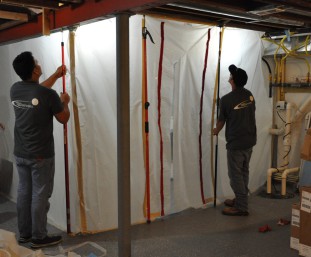Asbestos Removal
Asbestos is a naturally occurring mineral that began being mined over 4,000 years ago; it became increasingly popular among builders and manufacturers in the late 19th century because of its sound absorption, resistance to fire, heat, electrical and chemical damage. During both World Wars asbestos was heavily used in the construction of ships and through the 1970s, asbestos was used to fireproof roofing and flooring, for heat insulation, and for a variety of other purposes. When asbestos is used for its resistance to fire and heat, the fibers are often mixed with cement or woven into fabric. Finally during mid-to late 1980s, public health concern focused on potential asbestos fiber exposures of building occupants and workers in buildings containing asbestos containing building materials (ACBM) and their risks of developing asbestosis, lung cancer or mesothelioma.
Since this increased awareness of the dangers of asbestos, it has produced a flood of federal, state, and local regulations. The most well-known and largest regulation in the United States is known as the Clean Air Act Asbestos NESHAP (National Emission Standards for Hazardous Air Pollutants) (see 40 CFR Part 61 Subpart M) which defines asbestos into 2 classifications:
Friable asbestos material - means any material containing more than one percent asbestos, that, when dry, can be crumbled, pulverized, or reduced to powder by hand pressure.
Examples (are including but not limited to): thermal system insulation for pipes, spray applied fireproofing, textured ceiling material
Nonfriable asbestos-containing material- means any material containing more than one percent asbestos, that, when dry, cannot be crumbled, pulverized, or reduced to powder by hand pressure.
Examples (are including but not limited to): floor tile, adhesive mastic, transite roofing or siding, wall board
State and local asbestos removal regulations are sometimes more stringent than the asbestos NESHAP regulations. The regulations and notification requirements differ between Maryland, Washington D.C. and Virginia. A knowledgeable, trained and licensed abatement contractor, such as TEG Services, is required in each state for any asbestos removal. If you own, manage, or lease property, before you make your building repairs, remember to ask yourself “Could this material contain Asbestos?” The penalties for a wrong decision are costly: health hazards, regulatory fines, and/ or civil court action. Our company stands ready to provide safe and effective asbestos removal services. TEG Services is prepared to provide our abatement services at any time of day for all size asbestos projects. From small amounts of pipe insulation to large amounts of VAT (vinyl asbestos tile) and mastic, we stand ready to provide a crew large or small to meet your needs.
Where to Find Us:
The Environmental Group, Inc.
dba TEG Services
11850 Trolley Lane
Beltsville, MD 20705-1179
Main Phone: 301-210-9500
Alternate Phone: 301-477-3288
Office Hours
Monday - Friday
9:30 am - 4:00 pm
Important Links
Please click on the following links below to get important federal and state environmental regulations:




